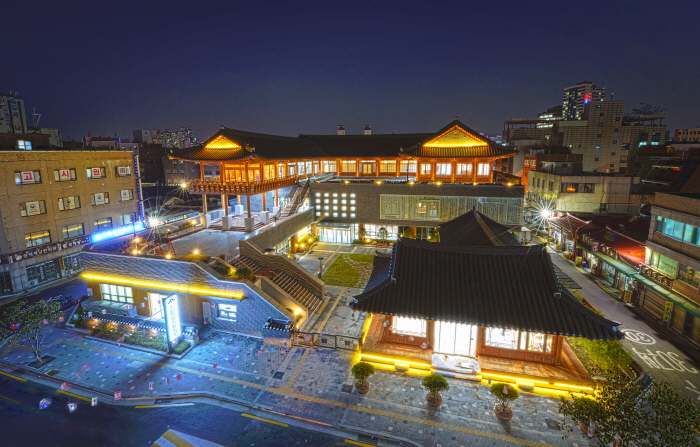Seoul Yangnyeongsi Herb Medicine Museum (서울약령시 한의약박물관)
5.8Km 2023-04-06
26, Yangnyeongjungang-ro, Dongdaemun-gu, Seoul
+82-2-969-9241
Seoul Yangnyeongsi Herb Medicine Museum opened in September 2006 on the grounds of Bojewon, a medical institution for the poor that was in operation during the Joseon dynasty. The museum was established with the goal of preserving and developing Korea’s herb medicine culture. In October 2017, the museum moved to the second floor of the Seoul K-Medi Center. The center provides both information and hands-on programs.
Evita Clinic (에비타흉부외과의원)
5.8Km 2025-10-23
(5th Floor, Burda Moon Building), 815 Nonhyeon-ro, Gangnam-gu, Seoul
In 2009, Evita Clinic launched healthcare services combining cosmetic procedures and surgeries with traditional thoracic surgery.
With the number of English-speaking patients gradually increasing, all staff members have come to speak English as a common language. We are evolving into a multinational clinic committed to raising awareness of Korea's advanced medical technology across the world.
Our director is a board-certified cardiothoracic expert with extensive experience of treating heart, vascular, and pulmonary diseases, thoracic deformities, and other severe illnesses at a university hospital. Building on the experience, His private practice, established in 2008, combines more than a decade of experience in dexterously suturing micro vessels with cosmetic and reconstructive surgery, perfecting his skills even further.
Seoul K-Medi Center (서울한방진흥센터)
5.8Km 2025-10-23
26 Yangnyeongjungang-ro, Dongdaemun-gu, Seoul
Seoul Yangnyeongsi Market is an herbal medicine specialty market that distributes 70% of the herbal medicines traded in Korea and is a Korean medicine-themed town with over a thousand businesses related to oriental medicine, including oriental medicine clinics and herbal medicine stores. The Seoul K-Medi Center, located in this center of Korean herbal medicine culture, is an oriental medicine complex cultural facility that promotes the excellence and safety of traditional Korean medicine through various exhibitions, education, and experiences. The building is unique in that it harmonizes the simplicity of modern architecture with Korean elegance. Visitors can enjoy various experiences in many different facilities in the center, including the Herb Medicine Museum, where one can expand their understanding of Korean medicine by examining over 300 types of medicinal herbs and their effects; the Herb Medicine Experience Room, where visitors can experience herbal medicine natural face packs and herbal heat packs; and Yakseon Food Experience Center, where visitors can learn about healthy recipes using medicinal herbs and make healthy foods.
CheongKwanJang - Seonghaengdang Branch [Tax Refund Shop] (정관장 성행당)
5.8Km 2024-04-18
1F, 465, Gosanja-ro, Dongdaemun-gu, Seoul
-
Hallym University of Graduate Studies (한림국제대학원대학교)
5.8Km 2025-01-10
405, Yeoksam-ro, Gangnam-gu, Seoul
+82-2-3453-9333
Founded in 2004 by Ilsong Educational Foundation, Hallym University of Graduate Studies is a private college located at 405, Yeoksam-ro, Gangnam-gu. Originally, it was founded as an international graduate college of Hallym University in 1997, but it has separated from Hallym University as of 2004.
EW Folder - Sangbong Branch [Tax Refund Shop] (EW 폴더 상봉)
5.8Km 2024-04-18
Sangbong Duo Turris, 131, Sangbong-ro, Jungnang-gu, Seoul
-
Olive Young - Sangbong Duoturris Branch [Tax Refund Shop] (올리브영 상봉듀오트리스)
5.8Km 2024-04-18
131, Sangbong-ro, Jungnang-gu, Seoul
-
Olive Young - Hwanghak Sageori Branch [Tax Refund Shop] (올리브영 황학사거리)
5.8Km 2024-04-17
410, Wangsimni-ro, Seongdong-gu, Seoul
-
Forever Plastic Surgery (포에버성형외과의원)
5.8Km 2025-10-23
(5th Floor, Patio9), 742 Nonhyeon-ro, Gangnam-gu, Seoul
Forever Plastic Surgery Gangnam is located near Hakdong Station on Subway Line 7 (Nonhyeon-dong, Gangnam). You can receive all cosmetic surgeries and procedures including facelifts, skin care, obesity, hair transplant, and non-surgical cosmetic procedures in one place. Our 8 medical staff with about 30 employees specializes in both dermatology and plastic surgeries. We can provide services in English, Chinese, Russian, and Japanese. With various procedures and laser equipment, we will guide you to the most suitable method according to your condition or recovery period.
Feel free to visit and receive consultation without any fee. In addition, we issue a reimbursement slip for refund at the airport refund counter.


![CheongKwanJang - Seonghaengdang Branch [Tax Refund Shop] (정관장 성행당)](http://tong.visitkorea.or.kr/cms/resource/89/2888889_image2_1.jpg)
![EW Folder - Sangbong Branch [Tax Refund Shop] (EW 폴더 상봉)](http://tong.visitkorea.or.kr/cms/resource/39/2888939_image2_1.jpg)
![Olive Young - Sangbong Duoturris Branch [Tax Refund Shop] (올리브영 상봉듀오트리스)](http://tong.visitkorea.or.kr/cms/resource/83/2889183_image2_1.jpg)
![Olive Young - Hwanghak Sageori Branch [Tax Refund Shop] (올리브영 황학사거리)](http://tong.visitkorea.or.kr/cms/resource/46/2888246_image2_1.jpg)
 English
English
 한국어
한국어 日本語
日本語 中文(简体)
中文(简体) Deutsch
Deutsch Français
Français Español
Español Русский
Русский